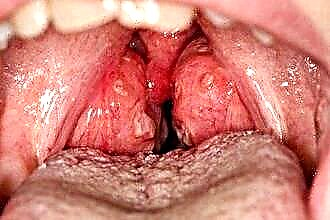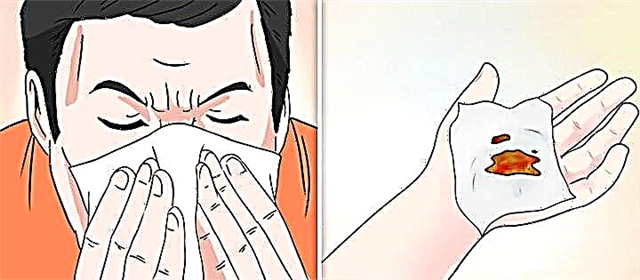 Thus, temporary hypertrophy of the palatine tonsils of the 1st degree is a variant of the norm for the acute period of an infectious disease. An enlargement of the glands to 2 and 3 degrees leads to the appearance of symptoms of the disease and requires treatment. Often, pathology occurs among children.
Thus, temporary hypertrophy of the palatine tonsils of the 1st degree is a variant of the norm for the acute period of an infectious disease. An enlargement of the glands to 2 and 3 degrees leads to the appearance of symptoms of the disease and requires treatment. Often, pathology occurs among children.
Glandular hypertrophy can develop in parallel with an increase in the pharyngeal or lingual tonsils. Often, an increase in the glands is diagnosed against the background of adenoids and vice versa.
Tonsils, depending on their size, can be classified as follows:
- 1 degree - characterized by a decrease in the lumen of the throat by a third;
- on the second degree - the diameter is narrowed by 2/3;
- the third degree is characterized by the connection of the surfaces of the tonsils, which completely closes the lumen of the throat.
Causes of hypertrophy
It is not possible to say exactly why the gland becomes hypertrophied. However, we can say with confidence that this is a protective reaction of the body to the action of an unfavorable factor.
In children, due to the underdevelopment of the immune system, the lymphoid tissue is very changeable, therefore, long-term action of the damaging factor is not required for its hyperplasia.
The predisposing factors that cause the proliferation of lymphoid tissue, which cause hypertrophy of the tonsils in children, include:
- decreased immune defense;
- exacerbation of chronic pathology;
- improper nutrition;
- frequent infections (ARVI, flu);
- the presence of an infection in the throat (pharyngitis) or nasopharynx (sinusitis);
- chronic tonsillitis, when microbes accumulate in the folds of the mucous membrane, supporting the inflammatory response;
- heavy physical activity;
- dry polluted air;
- professional harm.
Note that children whose parents suffered from adenoids or had tonsils removed from them, that is, with a burdened heredity, are more often affected.
How does it manifest?
When contacting an otolaryngologist, in most cases, the proliferation of lymphoid tissue is diagnosed not only of the glands, but also of the pharyngeal tonsil. The severity of clinical symptoms depends on the degree of hypertrophy of the tonsils and the overlap of the larynx.
When you try to independently examine the tonsils in the mirror, only at the second and third degrees can you notice their increase. Growths of the 1st degree are not so noticeable, so the person does not pay attention to the symptoms. Gradually, when grade 2 tonsil hypertrophy develops, signs indicating the disease begin to appear. As the glands increase, they are soldered between themselves and the palatine tongue.
By consistency, the tonsils become compacted with a hyperemic (with inflammation) or pale yellow color. You can clinically notice the hypertrophied appearance of the tonsils by the following signs:
- the child begins to breathe heavily, this is especially noticeable when he plays outdoor games;
- difficulty swallowing;
- there is a foreign element in the pharynx;
- the voice changes, becomes nasal. Sometimes it is not possible the first time to understand what the child is saying, because some sounds are distorted;
- snoring and coughing is sometimes noted.
With further proliferation of lymphoid tissue, the passage of solid food becomes difficult. With inflammation of the tonsils, angina develops. It is characterized by:
- acute onset;
- rapid deterioration of the condition;
- febrile hyperthermia;
- purulent plaque on the tonsils, follicular suppuration, pus in the lacunae.
Diagnostic examination
To make an accurate diagnosis, you need to see a doctor:
- at the first stage, the doctor interrogates complaints, examines the features of their appearance, and also analyzes the history of life (living conditions, past and existing diseases). In addition, regional lymph nodes are probed for inflammation;
- at the second stage, pharyngoscopy is performed, which makes it possible to examine the condition of the tonsils, assess the prevalence of the process and establish the degree of proliferation of lymphoid tissue. Rhinoscopy is also recommended;
- the third stage includes laboratory diagnostics. For this, the patient is sent for microscopy and culture. The material for examinations is a swab from the tonsils.
Analyzes make it possible to confirm or exclude an infectious lesion of the glands, as well as to establish the sensitivity of microbes to antibiotics.
To identify complications, otoscopy, rigid endoscopy, fibroendoscopy, and ultrasound are done. In the process of diagnosis, hypertrophy must be differentiated from chronic tonsillitis, oncopathology and abscess.
Conservative direction in treatment
Before deciding what to use for treatment, it is necessary to analyze the results of the diagnosis. Especially it is necessary to take into account the degree of proliferation of lymphoid tissue, the presence of infection and inflammation.
For a system action, the following can be assigned:
- antibacterial agents (Augmentin, Zinnat);
- antiviral drugs (Nazoferon, Aflubin);
- antihistamines that reduce tissue edema (Diazolin, Tavegil, Erius);
- vitamin therapy.
For local effects, rinsing the throat with solutions with antiseptic and anti-inflammatory effects are shown. Furacilin, Chlorhexidine, Givalex and Miramistin are suitable for the procedure. Rinses with decoctions of herbs (chamomile, yarrow, sage) are also allowed.
If necessary, lubricate the tonsils with solutions with an antiseptic, drying and moisturizing effect. To adequately assess the effectiveness of drug therapy, it is necessary to regularly visit a doctor and undergo diagnostics. A good result can be achieved by simultaneously strengthening the immune defense.
Surgical intervention
Grade 3 palatine tonsil hypertrophy in children should be treated surgically. With such an increase in the glands, not only the symptoms of the disease disturb, but also complications appear. Breathing disorder is fraught with hypoxia, from which the child is sleepy, inattentive and capricious.
Removal of tonsils, or tonsillectomy, lasts no more than 50 minutes.
To prepare for the operation, you must undergo a complete examination to identify contraindications.
Surgical intervention can be tolerated if:
- acute course of an infectious disease;
- exacerbation of chronic pathology;
- coagulopathy;
- uncontrolled diseases of the nervous system (epilepsy);
- severe bronchial asthma.
In consultation with an otolaryngologist, the question of removing the adenoids together with the glands in case of their hypertrophy may be considered. Before the operation, it is necessary to find out the presence of allergic reactions to local anesthetics (novocaine, lidocaine).
Surgery can be performed under local anesthesia or general anesthesia. This is determined by the anesthesiologist during the conversation and according to the results of the diagnosis.
Usually tonsillectomy is carried out as planned, so you can fully examine the child, thereby preventing complications and facilitating the course of the postoperative period.
Hospitalization for surgery is performed when the child:
 labored breathing;
labored breathing;- snore;
- changed speech;
- hypertrophy of the palatine tonsils of the 3rd degree.
In the postoperative period, as well as before surgery, parents should be close to the child.This will calm him down a bit and make the work of the surgeons easier. If the child is emotionally labile, in order to prevent it from being pulled out of the hands of the medical staff during the operation, general anesthesia is chosen.
It is forbidden to cough and talk immediately after the operation so as not to injure the blood vessels and cause bleeding.
Do not be alarmed if the child will saliva copiously with an admixture of blood. By agreement with the doctor, you can drink water after a few hours, preferably through a straw.
From the second day on, liquid foods such as yogurt, kefir or broth are allowed. Brushing your teeth should be postponed for a few days. We emphasize that after the operation it can:
- soreness appears when swallowing, as a response to tissue injury. To reduce pain, analgesics are prescribed;
- subfebrile hyperthermia;
- regional lymphadenitis;
- crusts in the throat;
- blood in the saliva.
Discharge is possible in 10 days, however, this does not mean that you can return to your usual life. It is also prohibited to eat solid food, hot drinks and heavy physical activity. It is necessary to remember about the sparing voice mode.
With a slight increase in the tonsils, dynamic observation of children by a doctor is necessary, because they can normalize the size of the tonsils. Complications of the operation are extremely rare, so it is considered simple for otolaryngology.
Preventive measures
To save a child from surgery, it is enough to adhere to the following recommendations:
- visit the dentist regularly for routine check-ups, because caries is a chronic infection;
- timely treat inflammation and infections of the throat (tonsillitis) and nasopharynx (sinusitis);
- prevent chronic diseases of internal organs;
- eat properly;
- give enough time to sleep and rest;
- often walk in the fresh air;
- regularly ventilate the room, do wet cleaning and humidify the air;
- go in for sports (swimming, cycling);
- avoid contact with allergens;
- have minimal contact with people with infectious diseases;
- do not visit crowded places during a flu epidemic;
- tempered;
- to heal the body in sanatoriums on the seashore, in a forest zone or in a mountainous area.
Hypertrophy of the tonsils in children is a fairly common pathology, but this does not mean that it cannot be avoided. Attention should be paid to the health of the child from birth to build a solid foundation for life.

 labored breathing;
labored breathing;

